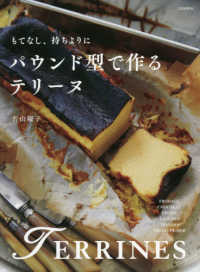- ホーム
- > 洋書
- > 英文書
- > Religion / Ethics
Full Description
Scholars working with ancient scrolls seek ways to extract maximum information from the multitude of fragments. Various methods were applied to that end on the Dead Sea Scrolls as well as on other ancient texts. The present book augments these methods to a full-scale protocol, while adapting them to a new computerized environment. Fundamental methodological issues are illuminated as part of the discussion, and the potential margin of error is provided on an empirical basis, as practiced in the sciences. The method is then exemplified with regard to the scroll 4Q418a, a copy of a wisdom composition from Qumran.
Contents
Acknowledgements
List of Tables and Figures
Introduction: The Present Volume
1 The Stegemann Method Reconsidered
Part 1: Methodology
1 Collecting the Materials
1 Tracing the Imaging History
2 Validating the Provenance of the Fragments
2 Margin of Error
1 Measurement Errors
2 Statistical Errors
3 Indirect Measurements
3 Image Manipulation
1 Enhancement and Manipulation
2 Digitally Repairing the Fragment
4 Scaling the Images
5 Removing the Background
1 Manual Removal of the Background
6 Finding Information on the Verso
1 Modern Stamps
2 The Title of the Composition
3 Opisthographs
4 Evidence for Additional Layers
5 Stitching Impressions
6 Mirror Writing
7 Finding Wads
1 Methods for Tracing Layers that Are Still Attached
2 Methods for Identifying Fragments that Originated from Wads
8 Reading and Text Reconstruction
1 Marking Doubtful Letters
2 Letter Cloning
3 Reconstruction Based on Parallels
9 Recreating Single Columns Based on Fragments and Parallels
1 Width
2 Height
3 Margins
10 Font
1 Designing the Font
2 Margin of Error
Appendix 1: Experiment for Validating the Use of a Custom-Made Font
Eshbal Ratzon, Einat Tamir, and Rivkah Madmoni
1 Introduction
2 Materials: The Examined Scrolls
3 Method
4 Results
5 Discussion
Appendix 2: Automated Font Generation
Bronson Brown deVost
1 Glyph Shape
2 Glyph Size
3 Vertical Glyph Position
4 Glyph Kerning
5 Word and Line Spacing
11 Damage Patterns
1 The Direction in which the Scroll Was Rolled
2 Wads
3 Establishing the Order of Scattered Fragments
12 Placing the Fragments on the Canvas Using the Stegemann Method
1 Columns and Margins in the Material Reconstruction
Appendix 3: Margin of Error for Placing the Fragments on the Canvas
13 Using One Prepared Copy as a Skeleton for a Second Copy
Appendix 4: Margin of Error for Chapter 13
Part 2: 4Q418a (4QInstructione)
14 Introduction to the Material Study of Instruction (Musar LaMevin)
1 Copies, Editions, and Reconstructions of Instruction
2 Material Information on 4Q418a
15 Re-Edition of 4Q418a
Eshbal Ratzon
1 Conventions of this Chapter
2 Wad A (frags. 1-8)
3 Wad B (frags. 9-12)
4 Wad C (frags. 13-14c)
5 Wad D (frags. 15-19)
6 Wad E
7 Single-Layered Fragments
16 Material and Digital Reconstruction of 4Q418a
Eshbal Ratzon
1 The Reconstruction of 4Q418a: State of the Art
2 The Wads
3 Reconstruction of 4Q418a
4 Placing the Fragments on the Canvas Using the Stegemann Method
5 Excursus: Calculating the Error for the Distance of Each Fragment from the Anchor Fragments and from Its Consecutive Fragment
6 Columns and Margins
7 Conclusion
17 Conclusion: Movement Towards a Comprehensive Reconstruction of Instruction
1 The Length of the Introductory Section in 4Q416, 4Q417
2 The Layout of 4Q415
3 Extrapolation for Other Copies of Instruction
Bibliography
Index of Qumran Scrolls
Index of Modern Authors
Subject Index








